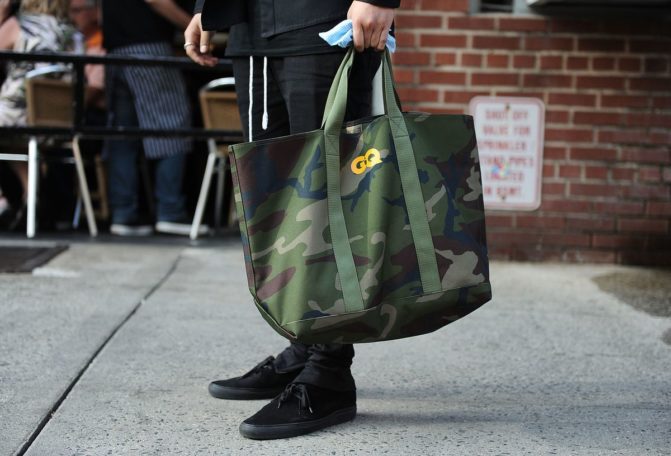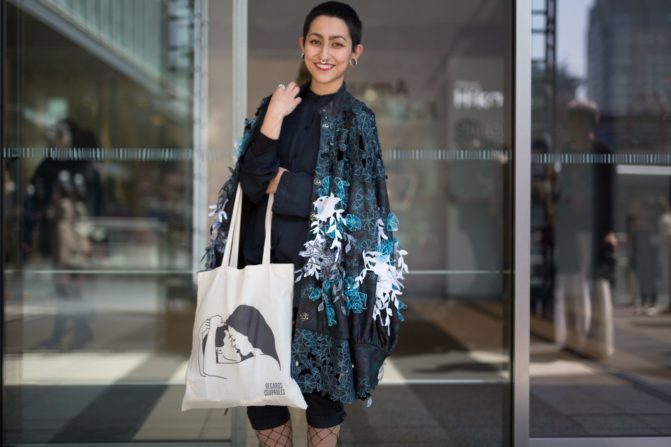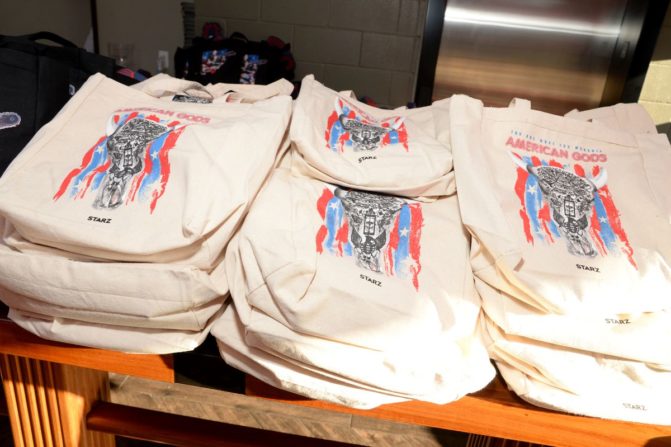From the carryall given away each year during your local public radio station’s pledge drive to the hipster bags with obscure artists and quotes to Madewell’s smart and sophisticated leather travel version, the humble tote serves many purposes. It can be dressed down or up depending on the occasion, and it’s incredibly handy to have around. Higher-end totes have been gaining in popularity; sleek, large bucket bags have graced the pages of many glossy magazines.
While the bag serves a useful purpose, its history is often overlooked. The etymology of the word tote — “to carry” — can be traced back to the 17th century. Fast-forward a few hundred years, when the actual bag reached popularity in the US during the 19th century. The humble tote has served many purposes over the years, but in the ’40s, the Maine-based outdoors store L.L.Bean helped to put this iconic satchel on the map.
 In 1944, L.L.Bean introduced its “ice bag,” which would help usher in the eventual tote-bag craze. “[The tote] began as the ice carrier and was re-introduced in the 1960s in the same form as it is built today,” says Mary Rose MacKinnon of L.L.Bean.
In 1944, L.L.Bean introduced its “ice bag,” which would help usher in the eventual tote-bag craze. “[The tote] began as the ice carrier and was re-introduced in the 1960s in the same form as it is built today,” says Mary Rose MacKinnon of L.L.Bean.
The design for L.L.Bean’s Boat Bag, which remains one of the company’s most popular items, was based on the design of the ice bag. Its original material — canvas — has stood the test of time.
Over the years, other elements were added, such as the handsome color trim, which was first offered in the 1960s. This design is an iconic part of the totes that L.L.Bean continues to make today. Over the years, knockoffs have appeared in Lands’ End catalogs and even craft stores, and many others have tried to imitate the style of the original design.
Now L.L.Bean sells the bag in a variety of sizes, handle lengths, materials, and finishes. It’s customizable, and the brand adds “new, on-trend colors seasonally,” MacKinnon says. Over the years, L.L.Bean has come to offer options like a zipper top, leather handles if you’re feeling fancy, and even waxed canvas.

Although the number of items sold per year by L.L.Bean is not public knowledge, MacKinnon says the company made over a half a million Boat and Totes each year in the company’s Brunswick, Maine, factory.
In the 1950s, the tote bag became a staple among housewives, who used them for many household chores. The ’60sushered in a new sense of political and social awareness that broadly affected fashion choices, including the choice of bags, and totes of all kinds became more popular.
It was during this decade that American designer Bonnie Cashin created the Cashin Carry Tote. Cashin’s elegant design (she later worked for Coach) helped to bring the tote to another level; there is an everyday ease about the bag that has yet to be captured by other retailers.
In the 1980s, iconic New York City bookstore The Strand introduced its version of the bag — which is still a staple on city streets today.
“The first Strand tote was introduced in 1980,” explains Lise Jee, lead designer with The Strand. “The tote was a blank stock tote, purchased in bulk. It was a natural cotton duck canvas, with an interior lining. In red Helvetica letters, the graphic boldly advertised the store’s name, address, phone number, and slogans like ‘18 miles of books.’”

Like the L.L.Bean tote, its design has evolved over the years, but its popularity continues to grow. In 2016 alone, over 89,000 Strand totes were sold.
A quick check of its website and you will find a tote in almost every color, adorned with a variety of images: animals; iconic city scenes; figures like Frida Kahlo, Ruth Bader Ginsburg, and Michelle Obama. Every tote features the bookstore’s iconic red label on the bottom. The demand for the bag has resulted in the production of other products, including pencil cases, backpacks, and bags in different sizes and shapes.
“Our designs are often inspired by the things happening in and around our community,” says Jee. “Our designs range from classic to cute to strong political statements like ‘Make America read again.’ Our design process is a group collaboration involving members from design, marketing, visual merchandising, and the owner of the store. It all starts with an idea, and from there we begin with simple sketch concepts and talk through changes until we have a finished product.”
Although there are a lot of moving parts in the creation of iconic totes, there is still a need to keep the designs fresh. Both L.L.Bean and the Strand approach this process differently. Both have created a product that people seek out for its quality craftsmanship and its stylist elements.

Over time, The Strand’s design team made improvements to the handles and added a Velcro closure to the inside of the bag. It’s also enlisted the help of artists like Art Spiegelman, Adrian Tomine, and Adam JK to develop different types of bags.
High-end totes are making their way down the runway as well. There’s the smart look of Coach’s bag; the popular Madewell totes; and iterations by Rebecca Minkoff, Tory Burch, and even Prada. Clearly, the tote has staying power, and many companies are eager to create their own versions. But the totes seen on the runway come in a variety of fabrics that set it apart from your average version.
While the canvas used to make L.L.Bean and Strand totes is certainly durable, there is a luxury component it doesn’t provide. From beautifully crafted leather to plush velvet, higher-end versions of the iconic tote can become the conversation piece of an outfit. But one major element that both the high-end and everyday version of these bags have in common is space. High-end totes arguably offer more room than your average purse.

Take the Madewell transport tote. It’s a bag that many women and men have sported over the last few years. It is definitely larger than your average tote, but boasts a level of sophistication that your day-to-day bag may lack.
“It came out of what our girl needed in a bag,” says Joyce Lee, head designer at Madewell, “something that is simple in form, utilitarian in function, can be used every day, and that’s the perfect complement to denim. It needed to be timeless, and the leather had to look better with age.”
Ikea has also popularized the tote: Its version of the oversized bag comes in different colors that people can purchase at the store or online. They are sold as an eco-friendly alternative to plastic bags. Since 2016, the iconic Ikea tote bags underwent a makeover — for the first time in 20 years. For its new, more sustainable design, the company brought on Hay. A high-end version of the Ikea tote was recently released by French luxury brand Balenciaga.
But it’s debatable whether grocery totes are actually better for the environment. Totes made for grocery shopping are constructed from recycled polypropylene plastic, canvas, or leather, depending on where they are purchased. A 2014 study found that about 40 percent of people forgot their reusable bags on trips to the store, and that they were only used about 15 times before they were thrown out.
Beyond their eco-friendly aspects, totes create a more personalized statement than just a regular purse. They offer a quirky take on the traditional women’s bag, are spacious, and can transition easily to fit many social functions. While the tote has undergone many makeovers over the years, it has stood the test of time and won’t be going anywhere soon.